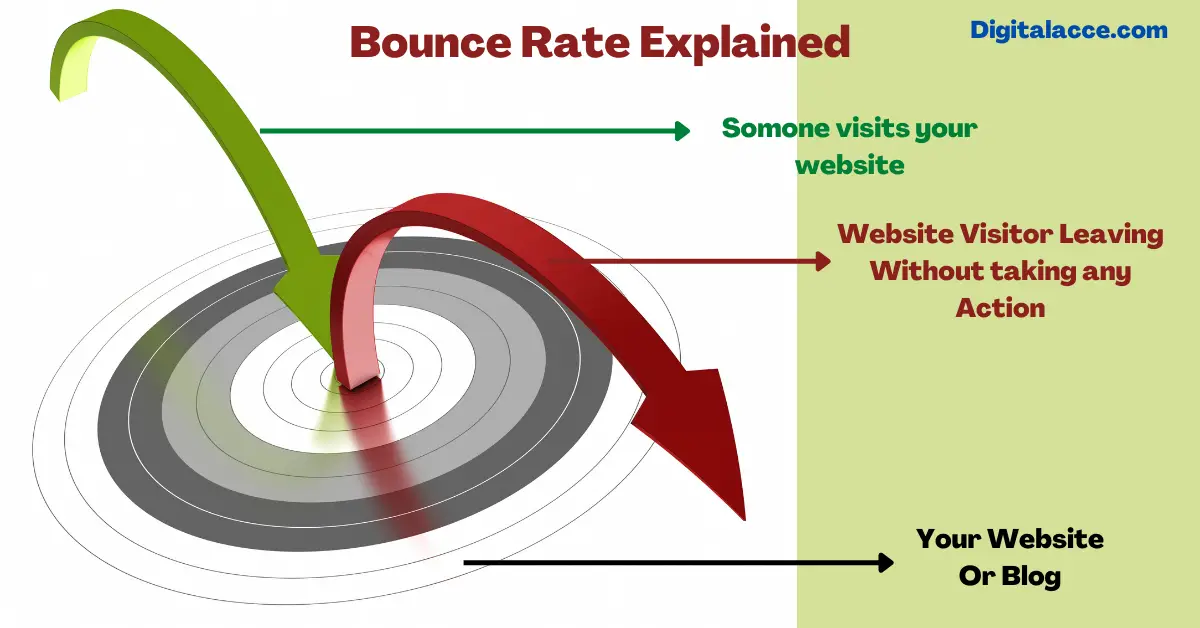For every website owner, bounce rate is a metric to watch and note. While you take note of bounce rate, it is important to find a way to improve and reduce it to the barest minimum possible.
In this article, I’ll show you five proven ways to reduce bounce rate to as low as possible.
But before we get going, let’s highlight the meaning of Bounce Rate once again. This is necessary so we can logically analyze how to reduce it.
Contents
What is Bounce Rate?
People could bounce off your website as a ball bounces off the ground.
Simply put, bounce rate is when readers exit your website without taking ANY action.
To explain further, imagine someone visiting your website from a search engine to find out information.
When someone hits your website, gets the info they need and exits without clicking anything on your site, it simply means they “bounced”.
So, in essence, the formula for calculating bounce rate metric is the total number of web visitors who took no action divided by the total number of web visitors multiplied by 100.
See below the formula for clarity’s sake:
Total number of web visitors who took no action ÷ Total Number of web visitors X 100
Usually, Bounce Rate is in percentage. The lower, the better.
Read Also: What Is Open Rate Metric In Email Marketing?
What is a Good Bounce Rate?
Even though many publishers understand bounce rates, they do not know what a good score is.
See below a standard rating of Bounce rate score:
- 100% Bounce Rate – Extremely poor and needs immediate fixing
- 80% – 99% Bounce Rate – Poor and needs improvement
- 70% – 79% Bounce Rate – Fair
- 60% – 69% Bounce Rate – Good
- 0% – 59% Bounce Rate – Excellent

A good bounce rate score is generally between 60% – 69%, while 70 – 79% is fair.
Now that you understand what bounce rate means, it’ll be easier to figure out how to reduce it.
So, let’s highlight five proven ways to reduce bounce rate to the bare minimum.
[Keep in mind that Google Is transitioning from UA to GA4. Learn the difference in the Guide.]
Read Also: Retargeting vs Remarketing Difference
5 Effective Ways To Improve Bounce Rate
Although there are many other ways to improve bounce rate, I’ll highlight the methods that have worked for me on my websites.
1. Write Quality Content
Writing quality content is the basis for any success in blogging or publishing.
You may wonder how quality content relates to Bounce rate, but I’ll explain.
Naturally, when a reader enjoys the content that brought him to your site in the first place, he’ll be curious enough to want to read another article that may interest him since he found the first one interesting.
On the other hand, when a reader does not find your article useful, do you think they’ll be keen to read another? Most likely not.
Although there are many things that makeup what we call “quality content”, here are a few things to keep in mind:
- Does your content match the intended search intent of readers? If not, readers would be so quick to bounce off your page.
- Is your content genuinely unique? If not, readers would find every opportunity to exit your page.
- Are your content well-structured and “skimmable”? Learn to highlight or bolden the main points in your article. Also, structure your content in logical subheadings and bullet lists, especially in the conclusion part.
- Add high-quality images where necessary and give readers a reason to pause their scrolling.
All of these leave lasting impressions in a reader’s heart, so it’ll be easier for them to want to carry out another action on your site, hence, improving the Bounce rate.
Read Also: Factors That Determine Success of An Ad
2. Intelligent Internal linking
Internal linking is one of the most underrated SEO practices. In reality, building internal links improves your SEO.
However, in this case, we want to consider how it directly affects bounce rate.
When internal links are placed intelligently, users are likelier to click them, reducing the bounce rate.
Here are some good techniques to keep in mind when adding internal links to your articles:
- Add in-content internal links naturally so it flows with the reading. Readers are more likely to click this type of link.
- Include a call to action before your anchor text
- Make sure the internal linking is as relevant as possible to the content.
- Repeat these techniques as many times as possible in content for all content you are publishing.
If you build internal links using these techniques, the bounce rate of your website will reduce.
Consider Reading: How To Ad Multiple Keywords Using Free Yoast Plugin
3. Place Related Posts on the sidebar
Most of the time, the sidebar is primarily used for vertical display ads, especially for desktop viewers.
However, you can make another good use of your sidebar by adding some of your best content.
Why is this important?
Any of your website visitors may stumble on the articles listed on the sidebar and could be curious enough to click on any of the articles.
This, of course, would reduce the bounce rate of your website.
Read Also: What Is Domain Authority?
4. Popups
Popups are used for various purposes on your website. However, it can also improve (or reduce) your bounce rate.
When you include a (redirect) link on your Popup to any landing page on your website, you are by far improving your bounce rate.
A simple “subscribe to our newsletter” popup could do the magic.
Add a redirect link to any landing page. It could actually be a “thank you for your subscription” page or any other related page.
The idea is to take readers from one page on your site to another without being intrusive or annoying.
5. Product Display
Smart product display could be another way to reduce your bounce rate to the bare minimum.
How can this be done?
You do not have to make it look like a regular display ad.
You could use any block with a combination of image and text plus a button conveying a call to action.
Affiliate marketers would understand this better.
Again, your goal is to move your reader from one page to another.
So, to reduce the bounce rate on your website in this instance, you should include a link to a landing page on your website.
One powerful tool you could use to display products in an attractive yet converting way is Lasso.

Bounce Rate vs Exit Rate
Many times, we may confuse bounce rate with exit rate.
In reality, both metrics are not the same.
Exit rate measures the number of times users exits your website via a particular page. For the exit rate to count, a user must have visited at least two pages on a website.
On the other hand, Bounce rate only counts when a user does not visit any other page and then exits.
The major difference between bounce rate and exit rate is the number of sessions carried out by a web visitor.
Read More: How Many Words Should Your Blog Post Have?
Conclusion
Bounce rate is an important metric, and you should try to reduce it as much as possible.
Remember these five effective ways to improve your bounce rate:
- Write quality content
- Intelligently linking content in your article
- Place other articles on your sidebar
- Use popups in a smart way
- Display products or services in an attractive way
Try these methods now to improve your Bounce rate.
Also, take note of the major difference between exit and bounce rates – the number of sessions carried out.
Finally, you could learn to remove MSCLKID, FBCLID, and GCLID from your Google Analytics report.


